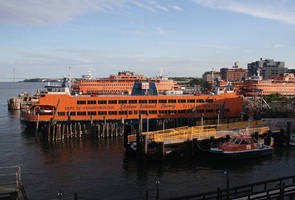Johnson Matthey to Provide SCR Systems for the John A. Noble Staten Island Ferry to Significantly Reduce NOx Emissions from Its Diesel Engines

The project is part of a long-range plan to reduce NOx and other emissions in the NYC Metropolitan Area
MALVERN, PA, April 4, 2011-Johnson Matthey, the global pioneer and leader in controlling emissions from mobile and stationary sources, has been awarded a contract by the Port Authority of New York and New Jersey and the New York City Department of Transportation to provide a Selective Catalytic Reduction (SCR) emission control system for the John A. Noble Staten Island Ferry. The John A. Noble has been in operation since 1986.
The project is part of ongoing efforts to reduce nitrogen oxide (NOx) emissions in the New York City metropolitan area as an offset to the emissions associated with the harbor deepening and dredging project, which will occur over the next decade.
Johnson Matthey's highly efficient SCR system is capable of reducing NOx and CO emissions by better than 90 percent and is the most effective and proven solution for NOx reduction, turning the pollutant into harmless nitrogen, water and CO2.
The 500-ton, 196-foot John A. Noble is capable of carrying nearly 1,300 passengers and is powered by two Caterpillar 3516 diesel engines. The ferry was built by Derecktor Shipyards, Bridgeport, Conn., which will install the new SCR system during routine maintenance scheduled to be finished in May 2011. M.J. Bradley, Manchester, NH, is the engineering consulting firm overseeing the project.
Using urea as the reducing agent, the John A. Noble SCR system includes a Johnson Matthey oxidation catalyst, SCR injection system, piping and urea ammonia grid. Two large urea holding tanks will be mounted on either side of the boat for better balance and the SCR system was designed to physically fit into the ferry's extremely tight quarters.
Johnson Matthey also supplied the SCR system for sister Staten Island Ferry, the Alice Austen in 2006. The Alice Austen SCR retrofit was a demonstration of proof-of-concept on older vessels. Ferries built more recently are equipped with emissions control systems that comply with air quality regulations standards.
The Staten Island Ferry makes over 35,000 trips annually and provides 20 million people a year with ferry service between St. George on Staten Island and Whitehall Street in lower Manhattan. A typical weekday schedule involves the use of five boats to transport approximately 60,000 passengers daily (109 daily trips). During the day, between rush hours, boats are regularly fueled and maintenance work is performed. On weekends, three boats are used (75 trips each Saturday and 68 trips each Sunday).
About Johnson Matthey:
Traded on the London Stock Exchange (symbol: JMAT), Johnson Matthey is a specialty chemicals company focused on its core skills in catalysts, precious metals, fine chemicals and process technologies. The $15 billion company was founded in 1817 and employs around 9,000 people in over 30 countries
About Johnson Matthey Stationary Emissions Control (SEC):
Johnson Matthey SEC is well known for its total systems approach to solving customer's emissions problems, as well as a reputation for strong customer support at the field service level. SEC designs and supplies catalysts and engineers catalytic systems to control emissions of nitrogen oxides (NOx), carbon monoxide (CO), hydrocarbons (HC), volatile organic compounds (VOC), hazardous air pollutants (HAPs) and particulate matter (PM). SEC is dedicated to the research, development and application of catalyst technology to improve quality of life by reducing air emissions.
Contact Information:
For Media: Please contact Allen Solovitz, Tel: 609-823-1247, E-mail perceptmkt@comcast.net
For more information about Johnson Matthey's Stationary Emissions Control (SEC): Please contact Wilson Chu, Business Development Manager, Johnson Matthey, 400 Lapp Road, Malvern, PA 19355, Tel: 484-320-2119, Fax: 484-320-2152, E-mail: chuw@jmusa.com, Website: www.jmsec.com




